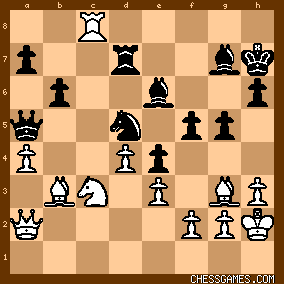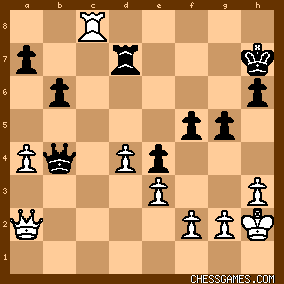|
< Earlier Kibitzing · PAGE 2 OF 2 ·
Later Kibitzing> |
Oct-14-17
 | | al wazir: I found the first move, with the threat against the ♘ on d5, but I foresaw *none* of what followed. It's hard for me to believe that Kamsky saw the whole combination before he played 32. Nc3, especially the final ♕ sac. |
|
| Oct-14-17 | | Walter Glattke: I could imagine, that 32.-Nxc3 is draw or black wins with 32.-f4 33.gxf4 Nxc3
34.Rxc3 Qxc3 35.Bxe6 Rxd4. Kamsky should not Play that against a Computer. |
|
| Oct-14-17 | | claudi: A very complicated position to me |
|
| Oct-14-17 | | Compound Error: I need to stare at the screen for quite a long time to work out the various combinations. However, my smartphone keeps blacking out to save energy, and there's no way to override it in the phone settings. Trying to keep the screen fresh by occasionally tapping it before it blacks out, and solving chess, is akin to some kind of circus act. I feel like a clown. |
|
| Oct-14-17 | | newzild: I've had a few Saturday-night wines and my two main candidates were 32. Nc3 or 32. Rc7, with the former (correctly) based on creating light-squared shenanigans.
However, I couldn't see far enough to claim that I solved this. The end of Kamsky's combination, from move 37, was truly spectacular. |
|
Oct-14-17
 | | Dionysius1: That becomes more beautiful the more I reckon out possible reasons for moves from 32 on. It's amazing how weak the squares around the K turn out to be. I didn't suspect that at move 32. I wonder whether Kamsky and the top players actually just see that from some sort of freakish pattern recognition (how complicated the pattern is!) or do they know in what circumstances to ask "OK - where are the weak squares? Anything I can do with them?". But there must be so many questions to ask like that - and not enough time or energy to ask them all each move, so they'd have to know in what sort of position to ask which questions. |
|
Oct-14-17
 | | ajk68: <Walter Glattke: I could imagine, that 32.-Nxc3 is draw or black wins with 32.-f4 33.gxf4 Nxc3 34.Rxc3 Qxc3 35.Bxe6 Rxd4. Kamsky should not Play that against a Computer.> Black is completely losing after 32. Nc3. 31...f5 was a huge mistake. Positionally it creates the light squared weakness that seal black's fate. It obviously created a wealth of tactical possibilities too. I am always impressed with GMs' awareness of the imbalances. I would have to think the light squared weakness prompted Kamsky to look for ways to exploit it, including the knight sac at e4. |
|
Oct-14-17
 | | ajk68: <Dionysius1: ...I wonder whether Kamsky and the top players actually just see that from some sort of freakish pattern recognition> I'm inclined to think they see light/dark squared weaknesses much like a club player sees a hanging piece: it's completely obvious. A lot of the ability is conditioned through coaching and experience. On top of that there is a gift in being able to formulate a strategy and calculate lines accurately. |
|
| Oct-14-17 | | mel gibson: Nothing much to see here folks.
The computer says:
32. Nc3 (32.
Nc3 (♘e2-c3 ♕b4-a5 ♘c3xd5 ♗e6xd5 ♗g3-b8 ♔h7-g6 ♗b3xd5 ♕a5xd5 ♕a2xd5 ♖d7xd5
♖c8-c6+ ♔g6-h5 ♗b8xa7 ♖d5-a5 ♗a7xb6 ♖a5xa4 g2-g3 ♖a4-a2 ♔h2-g1 ♖a2-b2
♗b6-d8 g5-g4 h3xg4+ ♔h5xg4 ♔g1-g2 ♔g4-h5 ♗d8-c7 ♖b2-a2 ♗c7-f4 ♖a2-d2
♖c6-b6) +1.73/20 116)
score for white +1.73 depth 20 |
|
| Oct-14-17 | | WorstPlayerEver: It's just logic; g6 is the only square left for the Black King. |
|
| Oct-14-17 | | Al2009: 32. Rc7!! was stronger and much more spectacular A)32... Nxc7 33. Bxe6 Nxe6 34. Qxe6 Re7 (34...Qe7 35. Qxf5+ Kg8 36. Nc3 +-)35. Qxf5+ Kg8 36. Qc8+ Bf8 36. Nc3 +- (36...Qa5 37. d5!-d6 etc.) B) 32...f4 33. Rxd7 hxg3+ 34. fxg3! Bxd7 35. Bxd5 Bf5 36. Qc2 Qe7 37. Nc3 +- C) 32...Rxc7 33. Bxd5 +-
D) 32...Qe7 33. Bxd5 +- |
|
| Oct-14-17 | | morfishine: What a wonderful series of moves, like magic, or witchcraft, depending on your point of view ***** |
|
| Oct-14-17 | | patzer2: After a long think, I finally guessed the correct first move for today's Saturday puzzle (32. ?) to be 32. Nc3!! due to the threat 32. Nc3!! Nxc3? 33 Bxe6! Nxa2?? 34. Bxf5#. Of course, even that line without the obvious Black errors is much more complicated than my simple calculation. For a follow-up, after 32. Nc3!! Qa5, I missed the clever and strong move 33. Qc2! (+2.77 @ 37 depth, Stockfish 8.) Instead, I opted for a more straight forward approach with 33. Nb5 +- (+3.13 @ 37 depth, Stockfish 8) which is also apparently winning. |
|
| Oct-14-17 | | Once: I think today's puzzle is in two halves.
The first half starts with a positional assessment. Here is the starting position: 
click for larger viewWhite would like to add more pressure to the pinned black Nd5. He would also like to activate his least-developed piece - the white knight sitting on e2. That suggests that 32. Nc3 is the move we'd like to play, but it seems to lose out of hand to 32...Nxc3 followed by Nxa2 capturing the white queen. Then we spot that 32...Nxc3? loses to the surprising 33. Bxe6 
click for larger viewWhite threatens mate with Bxf5+. Black has several defensive tries but none that work. That means that black has to suffer the white knight to stay on c3. His only realistic choice is 32...Qa5. That brings us to here (which is as far as I got in human mode): 
click for larger viewNow things get a lot murkier. We have developed our last lazy piece, black is in a bind protecting his minor pieces and we've got all the momentum. It's the end of the first stage, but I couldn't see a clean kill from here. Fritzie offers 33. Nb5 (+2.05), 33. Nxd5 (+1.68) and 33. Qc2 (+1.42). So for me this is end of (petit) combination. White has improved his position but doesn't yet have a killing blow. Kamsky's 33. Qc2 is the third best (according to Fritz) so everything that follows it is moot. Fritzie recommends 33...Nb4 when the bishops come off and white probably wins a drawn out endgame thanks to his passed pawn. It's only black's poor move of 33...Bf7 which makes the final combination possible. All things considered, the main part of the puzzle seems to be spotting that 32. Nc3 is both desirable and playable. The rest of the game seems to have both players playing less than ideal moves. Good attack by Kamsky when it does get going, but it's certainly not forced from the starting position. |
|
| Oct-14-17 | | thegoodanarchist: Well played by Gata! |
|
| Oct-14-17 | | zborris8: Black should have awarded the mate, both ears, and a tail! |
|
Oct-14-17
 | | Jimfromprovidence: Really liked the analysis of <Once> Here's the original position.

click for larger view Here's a "dream" interpretation of that position. 
click for larger view |
|
| Oct-14-17 | | Amulet: <chrisowen>
Hahahahaha! that's funny, hahaha! |
|
Oct-14-17
 | | dorsnikov: I'm with al wazir 100%. I got the first move, but I can't believe a human mind could have foreseen all the subsequent moves leading to the combination. |
|
| Oct-14-17 | | BOSTER: Maybe, was better to play 32...Qxc3 than Qa5. |
|
| Oct-14-17 | | zborris8: <chrisowens> The trouble with "stream of consciousness" is when the writing style is bound by habit rather than liberating thought. Your key words of habit since 2016: vow
von
von
viva
viva
vis
vim
vide
vet
vast
guv
ave |
|
Oct-14-17
 | | Jimfromprovidence: I'm amending my original post.
Ordinary player sees the puzzle position below and says what do I do? 
click for larger view A grandmaster sees the puzzle position and visualizes a mate in one. 
click for larger view |
|
| Oct-14-17 | | agb2002: The material is identical.
The pressure along the a2-g8 diagonal and the possibility of attacking the black king using the light squares suggest 32.Nc3: A) 32... Nxc3 33.Bxe6
A.1) 33... Nxa2 34.Bxf5#.
A.2) 33... Kg3 34.Rxc3 Rd7 (34... Qxc3 35.Bxd7 wins a bishop) 35.Rc6 wins a bishop at least. A.3) 33... Qa5 35.Bg8+
A.3.a) 35... Kh8 36.Bh7+ Kxh7 (36... Bf8 37.Rxf8+ and 38.Qg8#) 37.Qg8+ Kg6 38.Rc6+ Kh5 39.Qe8+ and mate next. A.3.b) 35... Kg6 36.Qf6+ Bf6 37.Qxd7 wins.
B) 32... f4 33.Nxd5 fxg3+ 34.fxg3
B.1) 34... Bxd5 35.Bxd5 and the threats Bg8+ and Bxe4+ seem to give White a considerable advantage. B.2) 34... Qd6 35.Nf6+ Bxf6 36.Bxe6 with the double threat Bxd7 and Bf5+. C) 32... Qa5 33.Nb5 with the threat Bd6 looks very good for White (33... Nb4 34.Bxe6 as above; 33... f4 34.exf4 gxf4 35.Bxf4 Nxf4 36.Bxe6 Nxe6 37.Qxe6). |
|
| Oct-14-17 | | PeterPringle: The ending is reminiscent of Fischer's victory over Rene Letelier. |
|
| Oct-15-17 | | Once: <Jimfromprovidence> You may well be right, but I wonder whether a really strong player would be so focused on a mate which could be blocked by Qe4 (your first dream position) or Rg7 (your second). I think that they would be looking first at strategic plusses, such as control of the open file, naked enemy king, protected passed pawn, well-placed pieces of their own and poorly placed pieces of the enemy. Then apply pressure. The possibility of a forced mate is one theme in this game, but largely as a way to force black to make concessions as he defends that mate. |
|
 |
|
< Earlier Kibitzing · PAGE 2 OF 2 ·
Later Kibitzing> |





